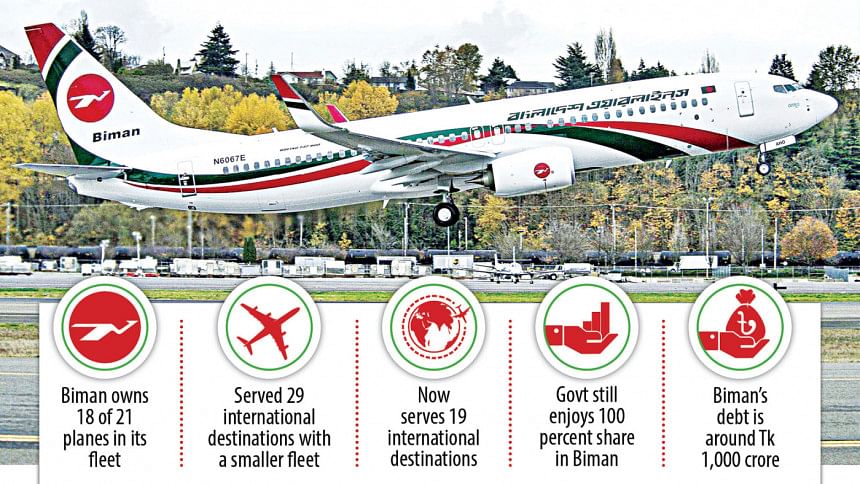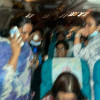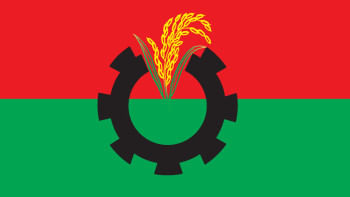Biman’s 50-year journey: Bumpy all along

Despite a robust fleet of 21 modern aircraft, Biman remains a losing concern due to a lack of planning and poor service delivery, said aviation experts.
The absence of planning ahead left many of its new aircraft underutilised and substandard services shrank its market shares over the years, they said.
Since its inception in 1972, the national flag carrier lost money in most of the fiscal years.
Biman made Tk 133 crore profit in 2020-21 (as of Dec 2020) and reported a loss of Tk 81.13 crore in 2019-20 fiscal year, according to Bangladesh Economic Review.
It owes over Tk 1,000 crore to different organisations and pays annual instalments of around Tk 250 crore for the new planes, according to aviation experts.
"Biman's profit actually cannot be called profit as the airline owes several hundred crores to Civil Aviation Authority of Bangladesh and Bangladesh Petroleum Corporation," Kazi Wahidul Alam, an aviation expert, told The Daily Star.
He also said Biman was not transparent with its financial statement.
It currently flies to 19 international destinations, most of which are short- or medium-haul. It had flights to 29 international destinations -- from New York in the west to Tokyo in the east and major European cities -- with fewer planes in its fleet, according to Biman insiders.
Since 2006, Biman gradually stopped serving around 10 destinations, including New York, Frankfurt, Rome, Tokyo, Brussels, Amsterdam and Libya, largely due to financial problems, shortage of modern planes, and routes becoming not viable.
After becoming a public limited company in 2007, Biman, to bolster its fleet, has been on a shopping spree since 2008 and spent around Tk 19,020 crore on new planes.
Despite having air service agreements with 42 countries, Biman failed to fly to new destinations or serve those it stopped serving, said Wahidul.
Even though it has a huge captive market and loyal passengers, Biman's market share has reduced 20 percent in recent years due to poor service, mismanagement, improper planning and marketing policy, and absence of professionals, he said.
He said over the 50 years, Biman could not directly recruit 50 professionals due to government interference. "Lack of experts and professionals left Biman in a nosedive and its world is gradually shrinking," he added.
A senior pilot, also a leader of Bangladesh Airlines' Pilot Association (Bapa), said it was unfortunate that Biman could not make a proper fleet plan to optimally use its modern aircraft.
For example, he said, "Biman is using Boeing 787-8s, a remarkable long-haul aircraft, on short-haul routes, including Dhaka-Singapore and Dhaka-Malaysia, which is nothing but bad planning."
He said the Boeing 787-8s can fly 14 to 15 hours at a stretch and is best suited for distant cities like New York, Toronto, or Tokyo.
Talking to The Daily Star, chairman, Biman Board of Directors, Sajjadul Hassan admitted that Biman could not achieve its target in the last 50 years.
"Passenger service quality did not reach the desired level due to various reasons," he added.
Speaking at a programme at the Biman's headquarters in Kurmitola in late November, he even said Biman's quality of service remains the same as before.
Former MD and CEO of Biman, MA Momen said there was no reason for Biman's inability to serve properly and survive in the market.
Biman MD and CEO Abu Saleh Mostafa Kamal said manpower shortage was the reason for Biman not flying to new destinations and serving passengers properly. He mentioned a shortage of pilots and cabin crew members.
Acknowledging passengers' allegations on the poor quality of service, he said, "Despite our limitations, we are sincerely trying to serve our valued passengers properly … ."
Biman started its commercial operations on February 4, 1972, with a single DC-3 aircraft.
It now has 21 aircraft -- four Boeing 777-300 ERs, four Boeing 787-8s, two Boeing 787-9s, six Boeing 737-800, and five De Havilland Canada DHC-8 Q400.

 For all latest news, follow The Daily Star's Google News channel.
For all latest news, follow The Daily Star's Google News channel. 








Comments